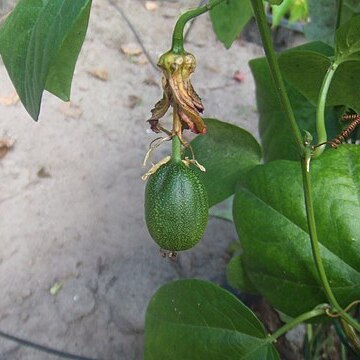Perennial climber to c. 5 m long, with simple axillary tendrils, pubescent or rarely glabrous. Stem terete, slender. Stipules linear, 1–4 mm long, c. 0.5 mm wide. Leaves alternate, 3–5-lobed (rarely not lobed and ovate) for about ⅓ to ½ of length; lobes broadest at base, triangular, acute, sometimes rounded or mucronate, each with a single main vein; lamina 3.5–12 (–15) cm long, (3.5–) 5–13 (–16) cm wide, without glands or with 1–3 (–8) scattered near leaf sinuses, base round to cordate, margin entire; petiole 1–5 (–7.5) cm long, with 2 dark glands (0.5–2 mm diam.) near lamina. Flowers bisexual, borne singly in leaf axils, 4–6.5 cm diam.; pedicels 1.5–3.5 cm long; bracts 3, filiform, 1–3 mm long, c. 0.5 mm wide. Sepals greenish yellow, yellow or orange, ageing salmon pink, 20–40 mm long, keeled. Petals greenish yellow, yellow or orange-yellow, ageing salmon pink, (5–) 8–22 mm long. Corona a single series of filaments, yellow, 4–15 mm long. Operculum white or yellow, membranous, plicate, 5–10 mm long. Androgynophore straight, 15–40 mm long. Stamens 5. Styles 3 (4). Fruit a subglobose to ellipsoidal berry, 2.5–7 cm long, 1.5–4 cm wide, green with pale spots. Seeds reticulate.
More
A vigorous climber. The young growth is hairy. The stems are slender and with a few hairs. The leaves are 6-12 cm long by 8 cm wide. They have 3-5 lobes. The leaves are deep green and the tips are pointed. The stalk is 7 cm long. There are 2 dark glands near the tip. The flowers are 7 cm across. They are cream but turn greenish-yellow then pink or orange. They occur singly in the axils of the upper leaves. The fruit are 5 cm long by 4 cm wide. They are oval.
A subtropical plant. It grows in wet sclerophyll forest in New South Wales and Queensland in Australia. Well drained acid soils in tropical, subtropical and warm temperate climates are best. It does best with light shade. A subspecies occurs on Norfolk Island.
More
Along the edges of rainforests and partly cleared areas. Widespread in moist forests near the coast and further inland.
Along the edges of rainforests and partly cleared areas. Widespread in moist forests near the coast and further inland.
Along the margins of rainforest and in wet sclerophyll forest, often in open or disturbed areas.

